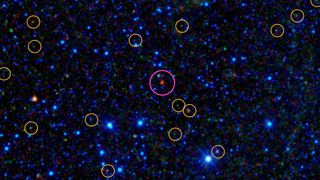
(Image credit ranking: NASA/JPL-Caltech/UCLA)
A team of astronomers combed by a assortment of unprecedented stars that are candidates for Dyson spheres — synthetic constructs designed by aliens to leech vitality from stars. As an different, the scientists stumbled on, the unique stars are extra doubtless to be “sizzling DOGs” — sizzling mud-obscured galaxies.
In early 2024, astronomers combed by bigger than 5 million stars from the Wide-discipline Infrared Glance Explorer, Gaia and 2MASS sky surveys, browsing for stars that looked as if it may maybe well well perchance occupy excess infrared radiation. Per the researchers, this extra infrared signal would be interpreted as the signature of a Dyson sphere.
First proposed within the 1960s by physicist Freeman Dyson, these hypothetical constructs would in actuality be immense shells that wrap round stars, exciting as mighty gentle vitality as doubtless. In Dyson’s principle, the topic topic used to earn these spheres would reach from disassembled planets in that star’s machine.
Alien civilizations may maybe well well exercise Dyson spheres to get millions of cases extra photo voltaic vitality than we now occupy earn entry to to on Earth whereas also giving themselves a spiffy new building to dwell to articulate the tale. But no vitality assortment or utilization machine is great. So, whereas the Dyson sphere collects radiation from the star on its interior, it also emits warmth from its exterior.
To us, that may maybe well well break a Dyson sphere appear as a celeb with mighty extra infrared radiation than same old. Within the most modern search, the astronomers identified seven stars within 1,000 gentle-years of Earth that emit an abnormally big amount of infrared radiation, making them Dyson sphere candidates.
Linked: 32 strange places scientists are procuring for aliens
But in a extra most modern evaluate printed to the preprint server arXiv in Would possibly maybe perchance, a brand new team of astronomers examined those seven candidates in increased component. They stumbled on that three are very shut to a wierd extra or less galaxy acknowledged as a sizzling mud-obscured galaxy, or “Hot DOG.”
Hot DOGs are surrounded by immense, thick clouds of mud, and warmth mud is amazingly steady at emitting infrared radiation. Due to the this reality, the astronomers suggest that for these three candidates, the excess infrared radiation is now not usually as a result of the star itself nonetheless moderately our ogle by the warmth mud surrounding a Hot DOG.
As for the other four stars? The researchers argue that thanks to the similarities within the somewhat about a wavelengths of sunshine emitted by all seven candidates, these stars are doubtless obscured by sizzling DOGs as properly, even if we build now not occupy detailed satisfactory observations in those directions to conclusively fetch the culprits.
While this new analysis would now not totally throw a wet blanket on the speculation of progressed alien civilizations turning their planets interior out, it would now not attend the total scrutinize for extraterrestrial intelligence. But it does novel steady how intricate astronomy may maybe well well be and how straightforward probability alignments can lead to beautiful results. Importantly, it demonstrates that if we enact ever fetch extra conclusive proof for aliens, we’re going to have to work flat out to point to they’re now not steady cosmic Hot DOGs.

Leave a Reply